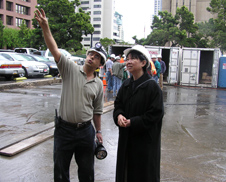Answering The Challenge

On August 1, 2008, 13 people were killed when the Interstate 35W bridge in Minneapolis collapsed during rush hour. A year later, a building in Brooklyn, New York, crumbled to the ground as firefighters arrived on the scene in response to a report of falling bricks.
Both incidents were sobering reminders that the nation’s aging infrastructure—bridges, roads, buildings and more—needs closer monitoring and intervention.
In fact, the necessity of restoration and maintenance of urban infrastructure is one of the National Academy of Engineering’s “Grand Challenges.” The American Society of Civil Engineering’s 2009 Report Card gave the nation’s infrastructure a grade of D.
At Northeastern, a group of experts, recently buoyed by a $9 million federal grant to develop technology to monitor the structural condition of roads and bridges, is moving forward with interdisciplinary research to develop better tools for monitoring and assessment.
The University has become something of a hub for infrastructure experts, says Sara Wadia-Fascetti, codirector of the federally funded Versatile Onboard Traffic Embedded Roaming Sensors (VOTERS) project.
“Infrastructural research at Northeastern has evolved to the point that we have expertise across many disciplines,” Wadia-Fascetti said, noting that research and programs in mechanical, electrical and civil engineering as well as in the social sciences are now connected to this research area.
In civil and environmental engineering, bridge infrastructure expert Ming Wang, and Mehrdad Sasani, an expert in structure collapse, are working on monitoring projects that will increase safety in their respective areas. Wang, who holds patents on sensors and systems used worldwide on bridge monitoring, received federal funds this year to develop a road-and-bridge-monitoring system that attaches to vehicles.
As part of the five-year VOTERS project, he will work alongside Wadia-Fascetti to develop onboard multi-sensor technology, equipping city buses with devices that would detect structural flaws in real time.
Sasani, whose research focuses on developing design guidelines for new and existing structures, hopes to work with Wang to develop wireless sensors that would help predict how manmade or natural catastrophes will cause a building to collapse.
Sasani noted that such technology would help predict how a building will fall in situations such as that created by the 9/11 attack on the World Trade Center towers.
Ultimately, the same sensor technology could be used to suggest the safest way to bring down a structure on purpose, said Wang.
While these and other researchers search for ways of safeguarding infrastructure, graduate students are learning to become leaders in the field of infrastructural assessment through the Integrated Graduate Education In Research Traineeship (IGERT) program.
The program, led by Wadia-Fascetti and Dionisio Bernal, associate professor of civil and environmental engineering, is another way the University is carving out a niche in this particular area, she said. Noting that other IGERT co-principal investigators include Barry Bluestone, dean of the School of Public Policy and Urban Affairs, Chris Bosso, associate dean, and Carey Rappaport, professor of electrical and computer engineering, Wadia-Fascetti said infrastructure issues cross many departments at Northeastern.
Bernal is monitoring the health of bridges, Rappaport is looking at the subsurfaces, and Bluestone and Bosso are expert in public policy issues related to infrastructure, she said.
Because the public owns roads and bridges, Wadia-Fascetti said it is critical to have policy experts on the team. “In order to make a difference, people like Barry and Chris can help navigate the political environment,” she said.
In a project last fall, Bosso’s students worked on assessing the economic, political and technical factors that played a role in the collapse of the I-35W bridge in Minneapolis.
“The politics of public budgets, public sector decision-making dynamics and ethical questions all … present challenges to engineers in the planning, implementing, financing and maintenance of infrastructure projects,” Bosso said.
To learn more about the College of Engineering at Northeastern University, visit: http://www.coe.neu.edu/
To learn more about the School of Public Policy and Urban Affairs, visit: http://www.policyschool.neu.edu/
This story was written by Susan Salk and Jason Kornwitz.
For more information, please contact Susan Salk at 617-373-5446 or at s.salk@neu.edu.